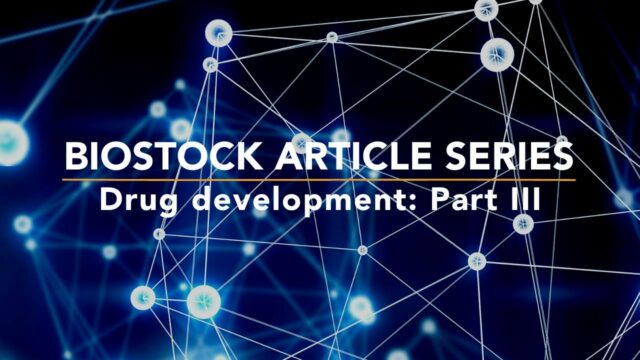
Drug development – A regulatory obstacle course
In this article series, we have already established that the regulatory framework for drug development entails a time-consuming and costly process. In this third part of the series, we take a closer look at today’s rigid regulations for drug development, how they have taken shape and what implications they have for the companies.
In the first two parts of this article series, we have outlined that the development of new drugs is a long process that entails high costs. Large parts of the costs are due to failed clinical trials, which can often be attributed to drug candidates’ failure to meet the strict safety requirements set by the Food and Drug Administration (FDA) in the US and the European Medicines Agency (EMA) in Europe.
In this article, we will take a short journey through the last century and how it has shaped today’s regulatory framework.
Read also:
Drug development part I – The four phases
Drug development part II – The challenges
Drug development part IV – Making treatments available
Drug development part V – The success of orphan drugs
Pharmacovigilance in the 1900s
To ensure that new medicines are not harmful to humans, the regulatory authorities introduced so-called pharmacovigilance.
The modern regulatory framework for pharmacovigilance mainly took shape after two catastrophic incidents in the 1900s. In 1937, a treatment based on sulfanilamide, which had been developed without any safety tests, led to the poisoning of more than 100 people in the United States. The following year, the US government passed the 1938 Food, Drug, and Cosmetic Act 1938, which required animal or cell culture experiments on drug candidates to prove the candidate was safe to use before tests in humans.
In the 1950s, a strong sedative called thalidomide (marketed in Sweden under the brand name Neurosedyn) – which had been produced in Germany to combat morning sickness – caused more than 10 000 children to be born with birth defects. As a result, the Committee on the Safety of Drugs (CSD) was founded in the UK in 1963.
In the United States, the Drug Amendments Act was passed in 1962, which made it possible to apply for new drugs through the New Drug Application (NDA). The change in the law paved the way for today’s requirement to first prove a new drug’s efficacy and safety to the FDA before it can be approved for use by patients.
A similar provision was adopted by the European Community (later the European Union, EU) in 1965 to ensure the safety of new medicines. This decision was followed by two groundbreaking directives, both enacted in 1975, aimed at creating a single European pharmaceutical market and facilitating the distribution of innovative medicines to patients throughout Europe.
Orphan Drug Act
In the 1980s, another law had a huge impact on drug development. The passing of the Drug Amendments Act had led to longer development times and increased drug costs that subsequently needed to be replaced. Pharmaceutical companies responded by focusing on common diseases to maximise R&D production and profits, leading to rare diseases being largely ignored, thus being called “orphan” diseases.
After strong lobbying, the US Congress passed the Orphan Drug Act in 1983 to encourage drug-developing companies to focus more on rare diseases. The law entailed tax incentives, strengthened patent protection, marketing rights and subsidies for clinical research for those who develop drugs aimed at rare diseases.
It was not until the year 2000 that the EU followed suit and set up the Committee for Orphan Medicinal Products (COMP). Drugs developed under COMP receive equivalent incentives in Europe as they receive through the Orphan Drug Act in the US, apart from the tax credits. COMP also requires the drugs to be targeted at serious medical conditions for which there are no alternative treatments on the market. These specific requirements are not enforced by the FDA, making it easier to obtain Orphan Drug Designation in the United States.
Designing strict guidelines
Over the years, the major regulatory authorities have established strict guidelines for drug development companies to follow. The guidelines are often updated as new challenges in drug development arise, and the main features of the regulations today consist of the following aspects
- Both the FDA and EMA have detailed guidelines for good pharmacovigilance practice (GVP) to ensure that new drugs are safe and do not cause serious side effects in humans. These guidelines apply from the idea conception stage up to and including the period when the finished medicinal product is marketed after marketing authorisation
- Good laboratory practice (GLP) is a set of guidelines that apply during the discovery phase and the preclinical development phases. The regulatory framework aims to ensure the safety and efficacy of all chemicals or biological substances tested. All substances must be proven safe not only for humans, but also for animals and the environment
- Good clinical practice (GCP) refers specifically to clinical trials, where the safety of the volunteers is the main priority. The basis of the GCP stems from the “Nuremberg Code” established after the Nuremberg Trials after World War II, which, in part, prosecuted Nazi physicians for their mistreatment of patients in clinical experiments. The GCP today applies the international ethical and scientific standards necessary for the proper design and conduct of clinical trials
- Good manufacturing practice (GMP) requires that products are consistently produced and controlled according to high quality standards, designed to minimise risks in all pharmaceutical production.
- Good distribution practice (GDP) ensures that medicines distributed for wholesale purposes maintain proper quality and integrity throughout the supply chai
Just the tip of the iceberg
The above-mentioned guidelines constitute a small but important selection of the regulatory framework that surrounds drug development. In the next part of this article series, we will examine some of the more modern regulations that – in response to the increasingly lengthy development times – aim to speed up the development process. The idea is to bring effective medicines to market more quickly and ensure that patients with urgent needs have earlier access to treatment.


